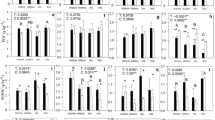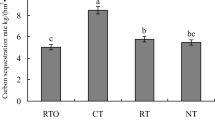Abstract
Purpose
A large body of research suggests that rice (Oryza sativa L.) cropping facilitates soil organic carbon (SOC) storage, while the stability of the sequestered carbon is still not well understood. The objective of this study was to determine the differences in SOC stocks and fraction distributions between rice paddies and upland cropping fields and their variation in different rice cropping areas.
Materials and methods
Data from the national soil survey were analyzed to assess the differences in SOC contents between paddy and upland cropping fields at the regional scale. In addition, three pairs of rice and upland cropping systems were selected in Heilongjiang [single rice vs. single corn (Zea mays L.) cropping], Jiangsu [rice-wheat (Triticum aestivum L.) vs. corn-wheat cropping], and Jiangxi (double rice vs. double corn cropping) provinces, representing the major cropping patterns in China. Physical fractionation techniques were used to investigate the differences in SOC stocks and distribution among different pools between rice-based cropping systems and non-rice cropping systems in China.
Results and discussion
SOC concentrations were, on average, 74.9% higher at the regional scale and 56.8% higher at the field scale in paddy than in upland cropping fields. Carbon proportion of particulate organic matter within microaggregates increased from 14.4% in upland cropping soils to 25.3% in paddy soils at the Heilongjiang site and from 12.4 to 25.5% at the Jiangxi site. Meanwhile, the free silt and clay-associated carbon was significantly greater in paddy than in upland cropping soils at the both sites. Nevertheless, SOC distribution did not markedly differ between paddy and upland cropping fields at the Jiangsu site where rice was rotated with winter wheat annually.
Conclusions
As compared to upland cropping or rice-upland crop rotation, continuous rice cropping, such as single and double rice cropping, could favor SOC stabilization by occlusion within microaggregates and adsorption to the silt and clay outside microaggregates, which may promote the long-term storage of SOC in paddies.






Similar content being viewed by others
References
Courtier-Murias D, Simpson AJ, Marzadori C et al (2013) Unraveling the long-term stabilization mechanisms of organic materials in soils by physical fractionation and NMR spectroscopy. Agric Ecosyst Environ 171:9–18
Denef K, Zotarelli L, Boddey RM, Six J (2007) Microaggregate-associated carbon as a diagnostic fraction for management-induced changes in soil organic carbon in two Oxisols. Soil Biol Biochem 39:1165–1172
FAOSTAT (2013) Database available online at http://faostat3.fao.org/home/index.html#HOME. Accessed 26 September 2013
Huang S, Rui W, Peng X, Huang Q, Zhang W (2010) Organic carbon fractions affected by long-term fertilization in a subtropical paddy soil. Nutr Cycl Agroecosys 86:153–160
Huang S, Sun Y, Zhang W (2012) Changes in soil organic carbon stocks as affected by cropping systems and cropping duration in China’s paddy fields: a meta-analysis. Clim Chang 112:847–858
Jastrow JD, Amonette JE, Bailey VL (2007) Mechanisms controlling soil carbon turnover and their potential application for enhancing carbon sequestration. Clim Chang 80:5–23
Kalbitz K, Kaiser K, Fiedler S et al (2013) The carbon count of 2000 years of rice cultivation. Glob Change Biol 19:1107–1113
Kögel-Knabner I, Amelung W, Cao Z et al (2010) Biogeochemistry of paddy soils. Geoderma 157:1–14
Li C, Huang S, Peng X, Huang Q, Zhang W (2009) Differences in soil organic carbon fractions between paddy field and upland field in red soil region of south China. J Agro-Environ Sci 28:606–611 (in Chinese)
Li Z, Pan G, Zhang X (2007) Topsoil organic carbon pool and 13C natural abundance changes from a paddy after 3 years corn cultivation. Acta Pedol Sin 44:244–251 (in Chinese)
Liu XL, He YQ, Zhang HL et al (2010) Impact of land use and soil fertility on distributions of soil aggregate fractions and some nutrients. Pedosphere 20:666–673
Lu R (1999) Analytical methods for soil and agricultural chemistry. China Agricultural Science and Technology. Press, Beijing (in Chinese)
Nishimura S, Yonemura S, Sawamoto T et al (2008) Effect of land use change from paddy rice cultivation to upland crop cultivation on soil carbon budget of a cropland in Japan. Agric Ecosyst Environ 125:9–20
Pan G, Xu X, Smith P, Pan W, Lal R (2010) An increase in topsoil SOC stock of China’s croplands between 1985 and 2006 revealed by soil monitoring. Agric Ecosyst Environ 136:133–138
Powlson DS, Whitmore AP, Goulding KWT (2011) Soil carbon sequestration to mitigate climate change: a critical re-examination to identify the true and the false. Eur J Soil Sci 62:42–55
Sahrawat KL (2004) Organic matter accumulation in submerged soils. Adv Agron 81:169–201
Saree S, Ponphang-nga P, Sarobol E, Limtong P, Chidthaisong A (2012) Soil carbon sequestration affected by cropping changes from upland maize to flooded rice cultivation. J Sustain Energy Environ 3:147–152
Schmidt MWI, Torn MS, Abiven S et al (2011) Persistence of soil organic matter as an ecosystem property. Nature 478:49–56
Six J, Callewaert P, Lenders S et al (2002a) Measuring and understanding carbon storage in afforested soils by physical fractionation. Soil Sci Soc Am J 66:1981–1987
Six J, Conant RT, Paul EA, Paustian K (2002b) Stabilization mechanisms of soil organic matter: implications for C-saturation of soils. Plant Soil 241:155–176
Six J, Elliott ET, Paustian K, Doran JW (1998) Aggregation and soil organic matter accumulation in cultivated and native grassland soils. Soil Sci Soc Am J 62:1367–1377
Six J, Paustian K, Elliott ET, Combrink C (2000) Soil structure and soil organic matter: Ι. Distribution of aggregate-size classes and aggregate-associated carbon. Soil Sci Soc Am J 64:681–689
Sleutel S, De Neve S, Németh T, Tóth T, Hofman G (2006) Effect of manure and fertilizer application on the distribution of organic carbon in different soil fractions in long-term field experiments. Eur J Agron 25:280–288
State Soil Survey Service of China (1993) China soil series, vol. 1. China Agricultural Press, Beijing (in Chinese)
State Soil Survey Service of China (1994a) China soil series, vol. 2. China Agricultural Press, Beijing (in Chinese)
State Soil Survey Service of China (1994b) China soil series, vol. 3. China Agricultural Press, Beijing (in Chinese)
State Soil Survey Service of China (1995a) China soil series, vol. 4. China Agricultural Press, Beijing (in Chinese)
State Soil Survey Service of China (1995b) China soil series, vol. 5. China Agricultural Press, Beijing (in Chinese)
State Soil Survey Service of China (1996) China soil series, vol. 6. China Agricultural Press, Beijing (in Chinese)
Tisdall JM, Oades JM (1982) Organic matter and water-stable aggregates in soils. J Soil Sci 33:141–163
West TO, Post WM (2002) Soil organic carbon sequestration rates by tillage and crop rotation: a global data analysis. Soil Sci Soc Am J 66:1930–1946
Wiesmeier M, Steffens M, Mueller CW et al (2012) Aggregate stability and physical protection of soil organic carbon in semi-arid steppe soils. Eur J Soil Sci 63:22–31
Xu Q, Rui W, Liu J et al (2006) Spatial variation of coupling characteristics of soil carbon and nitrogen in farmland of China. J Ecol Rural Environ 22:57–60 (in Chinese)
Yan X, Cai Z, Wang S, Smith P (2011) Direct measurement of soil organic carbon content change in the croplands of China. Glob Change Biol 17:1487–1496
Yan X, Zhou H, Zhu QH et al (2013) Carbon sequestration efficiency in paddy soil and upland soil under long-term fertilization in southern China. Soil Tillage Res 130:42–51
Yu Y, Guo Z, Wu H, Kahmann JA, Oldfield F (2009) Spatial changes in soil organic carbon density and storage of cultivated soils in China from 1980 to 2000. Glob Biogeochem Cycles. doi:10.1029/2008GB003428
Zhang W, Xu M, Wang X et al (2012) Effects of organic amendments on soil carbon sequestration in paddy fields of subtropical China. J Soils Sediments 12:457–470
Zhou P, Song G, Pan G, Li L, Zhang X (2009) Role of chemical protection by binding to oxyhydrates in SOC sequestration in three typical paddy soils under long-term agro-ecosystem experiments from South China. Geoderma 153:52–60
Acknowledgments
This work was supported by the National Key Technology R&D Program of China (2011BAD16B14), the Program for New Century Excellent Talents in University (NCET-05-0492), the Foundation of Jiangxi Province (GJJ12245, QN201102), and the innovation program of Chinese Academy of Agricultural Sciences. Great thanks to Changxin Li, Yang Yu, Jinxia Feng, and Qianru Huang for laboratory and fieldwork.
Author information
Authors and Affiliations
Corresponding author
Additional information
Responsible editor: Chengrong Chen
Rights and permissions
About this article
Cite this article
Huang, S., Pan, X., Guo, J. et al. Differences in soil organic carbon stocks and fraction distributions between rice paddies and upland cropping systems in China. J Soils Sediments 14, 89–98 (2014). https://doi.org/10.1007/s11368-013-0789-9
Received:
Accepted:
Published:
Issue Date:
DOI: https://doi.org/10.1007/s11368-013-0789-9




